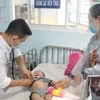Hanoi (VNA) – The number of new HIV infections has been on the rise in Vietnam, especially among men who have sex with men (MSM) and those with unsafe sexual behaviours, heard a conference on policies for HIV/AIDS prevention in Ho Chi Minh City on September 27.
More than 4,540 HIV infections had been detected in the first half of 2017, raising the total number in the country to 209,591, according to Nguyen Hoang Long, head of the Vietnam Administration of HIV/AIDS Control.
Of them, 56 percent are getting anti-retroviral (ARV) therapy, he said, adding the total number of AIDS patients is 90,190.
Nine provinces and cities are yet to complete a project on allocating finance for HIV/AIDS prevention, he said.
It is expected that health insurance would cover ARV drugs from 2019, and the ratio of people with HIV/AIDS who have insurance increased from 64 percent February last year to 76 percent in June, he said.
In 34 provinces, more than 80 percent have insurance, he added.
At the conference, UNAIDS country director Marie Odile Emond said Vietnam needs to sustain its strong political commitment and increase spending on HIV prevention and treatment to maintain its hard-gained achievements and to fast track its HIV response towards ending AIDS by 2030.
Almost half of all HIV patients in Vietnam get treatment allowing them to enjoy longer and productive life and take care of their families, she said.
“This means that more than half of people with HIV who very much need treatment do not get it.”
With still around 11,000 new HIV infections and 8,000 HIV-related deaths every year, Vietnam continues to face a major public health threat, he stated.
“Though every new HIV infection is preventable, especially mother-to-child transmission, every year a few hundred Vietnamese infants are born with HIV.”
Young people’s knowledge of HIV remains limited, and thus the younger generation whom Vietnam’s future relies on, is still much at risk of HIV and progress could be reserved, she warned.
The HIV epidemic and response are uneven across the country, and evidence shows have become more serious in certain areas and among key populations, she said.
This complex dynamic requires continued determination and a well-adapted response, she said.
“Investing in the HIV response will not only ensure that no one is left behind and at risk without access to HIV information and services, but will also enable more people living with HIV to be part of the national solutions towards ending AIDS.”
Vietnam would be able to end AIDS as a public health threat by 2030, she said.
“Though we will continue to support Vietnam to mobilise external support, in the context of fast reduction of donor funding for HIV due to Vietnam’s strong economic development and with a view to further ensuring the sustainability of the HIV response, HIV should be integrated in the national and provincial socio-economic development plans” she said.-VNA
VNA
























